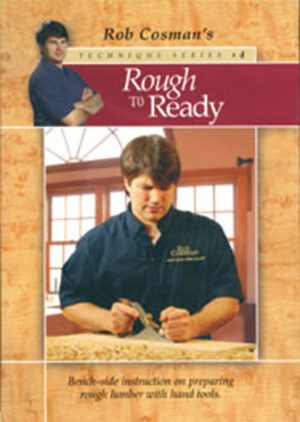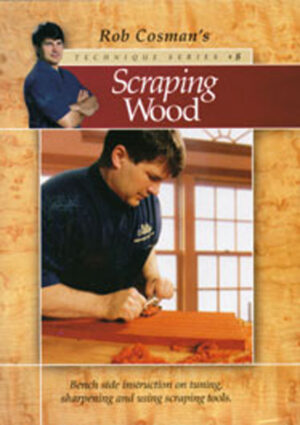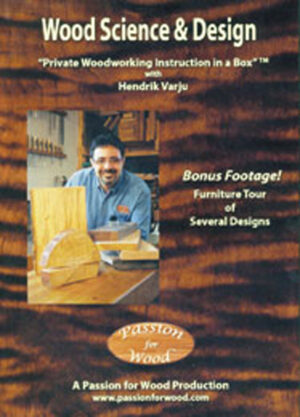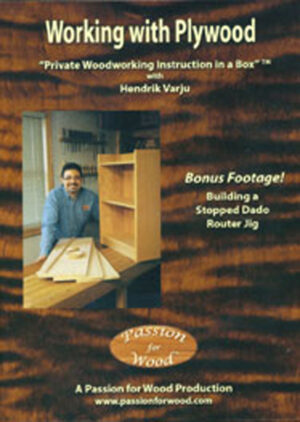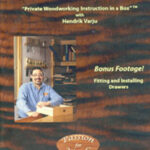MAKING DRAWERS DVD
$120.00
Private Woodworking Instruction in a Box
with Hendrik Varju
Produced by Passion for Wood, Ontario, Canada
ISBN 978-0-9881280-4-0
As reviewed in The Australian Woodworker Issue 181
Watching one of Hendrik Varju’s presentations may remind you of a time when you taught someone to drive. Telling a student how to do something can take longer than actually doing it yourself.
Reviewers, being human, and being already acquainted with at least some of the subject material, may therefore occasionally let their attention wander while watching one of his videos. But just when that happens, there always seems to be a sudden need to hit the pause button, then go back and see that bit again.
This is because the path between the beginning and end of a Hendrik Varju project is never straight. If Hendrik picks up a saw, a chisel, a dado set, a piece of wood… he almost always has a comment to make about it.
These comments are never less than pertinent and they help to flesh out the basic information that a student may have already gained on the topic. They are not diversions, but expansions that frequently offer surprising insights and new opportunities to achieve better results and greater enjoyment from the craft.
One of the many examples, that can be chosen from just the first few chapters on this set of DVDs is the way in which a board might be selected from several that have been milled for the sides of a drawer.
Varju suggests that one element in the selection may be the appearance of the top edge of the board. If it exhibits a particular pattern, is this similar to the pattern on the top edge of the board on the other side of the drawer? A marked difference between the two could spoil the appearance of the whole drawer.
The construction may be just as strong, and the drawer may satisfy every other criterion, but it would still not be as good as it could have been.
Does it matter whether the growth rings on the sides of a drawer face in or out? Varju argues that if the concave rings face out, then a change in the ambient humidity could make the boards tend to cup inwards (ie. in the opposite direction to the growth rings). If this happens, then the top and bottom of the corner joint will tend to press harder together.
If the growth rings are placed the other way round, and the opposite occurred, even a small movement would be noticed in a slight, but ugly opening of the joint.
A similar consideration of growth rings is applied much later when inserting the dowels that Varju uses to re-inforce the joints between the front and sides of his drawers.
While these particular comments relate to the project itself, there are equally many that refer to the workshop equipment or its method of use.
For instance, Varju makes his own stop blocks for his custom-built router table. The fence on this table has a slot running almost its entire length.
When a stop block is needed, it is bolted to the fence through this slot. The stop blocks sit about a centimetre above the table and have a rebate about the same size on the inner edge (that faces the fence).
These two gaps allow sawdust to escape rather than build up against the block so that subsequent workpieces can’t be placed in exactly the same position. The error would be small, but not too small to make a difference when working to Hendrik Varju’s high standards.
The way in which Varju uses his thicknesser is also of special interest. He accepts the fact that conventional blades can rarely, if ever, be set so that their cutting edges are exactly parallel to the table. He uses this ‘fault’ to take cuts of a fraction of a millimetre off the sides of a drawer.
It’s a fine balance between removing a thin shaving and leaving pressure roller marks – but he shows that with care, his method can save time and effort and achieve remarkably good results.
The drawer design that is used for the demonstrations contained in these videos is one that Hendrik says he uses for most of his work. It is sturdy and attractive but less time consuming to make than traditional dovetailed drawers. (He comments that he still makes these for customers who are prepared to pay for them.)
Grooves in the sides of the drawers are supported by runners attached to the inside of the cabinet.
Vertical dadoes are cut in the sides to accept the back of the drawer, while the front is rebated to accept the sides before these joints are strengthened with dowels. These pinned joints are pleasing to the eye and much faster and easier to make than dovetails.
As you might expect, Hendrik has his own way of refining store-bought dowels (which are generally oval) so they can produce gap free joints.
The bottom of the drawer is made from ply or, occasionally, from solid material.
The final form of the drawer is heavier than some might expect in fine woodworking, but Hendrik justifies this is in a brief discussion at the end of the videos.
He remarks that he has had to repair many pieces of furniture because their construction was too light, but has never had a customer complain that the pieces he makes are not strong enough.
DVD 1 discusses the basic types of drawer, the design of a true front drawer (ie. as opposed to one with a false front), a detailed analysis of the operations necessary to complete construction and the cutting of rabbet joints on the table saw.
DVD 2 deals with cutting dado joints on a table saw, milling the drawer back to fit the dado, cutting grooves for the drawer bottom, completing the back and cutting the grooves for the runners. This competes the preparation of all of the components.
DVD 3 begins with the glue-up, then demonstrates the preparation of dowels and insertion to pin the front to side joints.
DVD 4 shows how the drawer bottom is made and inserted and adds information on finishing touches as well as fitting and installing drawers.
DVD 5 provides detailed guidance in the use of metal drawer slides and also contains Varju’s personal reflections on some topics related to woodworking.
It has been said before, but it bears saying again, that it is the meticulous attention to detail and the ferreting out of every subtle nuance of a decision or action, that is the strength of Varju’s presentations.
The videos should therefore prove of value to woodworkers of virtually every level of knowledge and experience.
Duration: 10hrs, 28mins, 5 discs
DVD – English – NTSC

